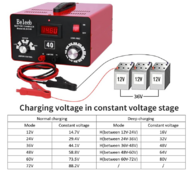42OhmsPA
What's in a title?
I was using 16AWG on the AC, ~20A16AWG is less than 1.5mm2, I wouldn't put 10A on it, let alone 40A.
6mm2 for 40A is a gamble (depending if PVC/XLPE Insulation and Installation Conditions among other Things), I would just take 10mm2 or, since I never use that size, standardize to 16mm2 since that's the next size I commonly use.
So probably AWG8 or AWG7 ...
I knew it was a bad idea when I grabbed it out of the pile, it was the only thing I could find that had an end on it.... It's been replaced (temporarily ) with 12AWG silicone insulation and a new cord end.
The 10AWG on the DC side is marine rated.
When I get everything wired up permanently I'm going to use 10AWG on the AC side and 6AWG or 8AWG on the DC side.
I'll be using it primarily with the 120V inverter generator in the winter but could also use the big noisy 240V generator.
Thank you for taking the time to reply.



